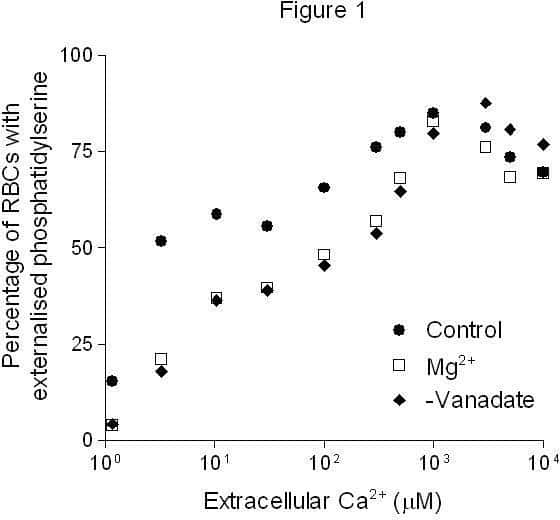Sickle cell disease (SCD) is associated with chronic anaemia and ischaemic complications such as pain, stroke, acute chest syndrome and osteonecrosis. Red blood cell (RBC) aminophospholipids (APs) like phosphatidylserine (PS) are mostly confined to the inner leaflet of the membrane. In SCD patients a significant proportion of RBCs (2-10%) have externalised PS (Kuypers, 2008) and values increase on deoxygenation. Exposed PS may therefore contribute to the complications of SCD. In RBCs, an ATP-dependent transferase (APLT or flippase) transports PS from outer to inner leaflet, whilst a Ca2+-dependent scramblase moves APs rapidly in both directions. PS exposure requires both flippase inhibition and scramblase activation. Ca2+ loading of RBCs causes both. Flippase inhibition occurs at high affinity (about 1μM) but scramblase activation is reported to be relatively insensitive (EC50 about 25-100 μM) (eg Kamp et al., 2001). Although sickle cells show perturbed Ca2+ homeostasis, especially when deoxygenated, it is unlikely that levels approaching 100μM could be reached (Lew and Bookchin, 2005). How then can Ca2+ loading contribute to PS exposure in vivo? We investigated this aspect further. Blood samples were obtained with ethical approval from consenting volunteers homozygous for HbSS or HbAA. RBCs were washed into saline, comprising (mM) NaCl 55, KCl 90, inosine 10 and HEPES 10, pH 7.4 at 37oC. RBCs (0.8% haematocrit) were then incubated for 30min with bromoA23187 (2-6μM) and vanadate (1mM – to inhibit APLT – unless indicated otherwise). Extracellular [Ca2+] ([Ca2+]o) was kept constant throughout using EGTA (2mM) and various total [Ca2+]os. RBCs were harvested and resuspended with lactadherin-FITC (16nM; Cambridge Bioscience) for 10min to label externalised PS. Fluorescence was then measured by flow cytometry (FACSCalibur, BD). Typical results for sickle cells are shown in Figure 1. Normal RBCs behaved similarly. Ca2+ consistently stimulated PS exposure biphasically with both high (EC50 1.8±0.3 μM) and low (306±123μM; means±S.E.M., n=5) affinity fractions. The high affinity component, which accounts for about 2/3rd RBCs with exposed PS, has not been hitherto described. Addition of Mg2+ or the absence of vanadate markedly reduces the high affinity component, providing a possible explanation for why it has been previously overlooked. Since low micromolar [Ca2+]is are achievable in vivo, these findings substantiate the hypothesis that altered Ca2+ homeostasis may contribute to RBC PS exposure, particularly in SCD patients.
University of Manchester (2010) Proc Physiol Soc 19, PC153
Poster Communications: High and low affinity components of Ca2+-induced phosphatidylserine exposure in red blood cells from normal individuals and sickle cell patients
E. Weiss1, D. C. Rees2, J. S. Gibson1
1. Veterinary Medicine, University of Cambridge, Cambridge, United Kingdom. 2. Molecular Haematology, King's College Hospital, London, United Kingdom.
View other abstracts by:
Figure 1. Effect of calcium loading on phosphatidylserine exposure in RBCs from sickle cell patients. Three conditions: (i) control, with 1mM vanadate; (ii) Mg2+ with 1.5mM Mg2+ in addition to vanadate; (iii) without either Mg2+ or vanadate. Single experiment representative of 6 others.
Where applicable, experiments conform with Society ethical requirements.

